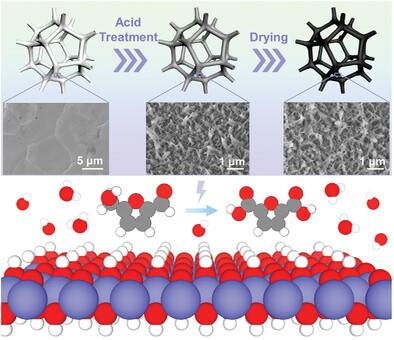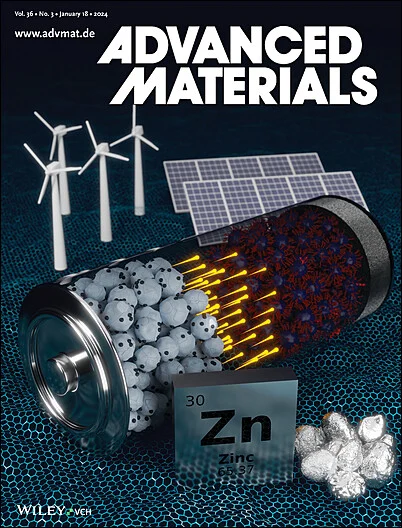Electrocatalytic Biomass Oxidation via Acid-Induced In Situ Surface Reconstruction of Multivalent State Coexistence in Metal Foams
IF 27.4
1区 材料科学
Q1 CHEMISTRY, MULTIDISCIPLINARY
引用次数: 0
Abstract
Electrocatalytic biomass conversion offers a sustainable route for producing organic chemicals, with electrode design being critical to determining reaction rate and selectivity. Herein, a prediction-synthesis-validation approach is developed to obtain electrodes for precise biomass conversion, where the coexistence of multiple metal valence states leads to excellent electrocatalytic performance due to the activated redox cycle. This promising integrated foam electrode is developed via acid-induced surface reconstruction to in situ generate highly active metal (oxy)hydroxide or oxide (MOxHy or MOx) species on inert foam electrodes, facilitating the electrooxidation of 5-hydroxymethylfurfural (5-HMF) to 2,5-furandicarboxylic acid (FDCA). Taking nickel foam electrode as an example, the resulting NiOxHy/Ni catalyst, featuring the coexistence of multivalent states of Ni, exhibits remarkable activity and stability with a FDCA yields over 95% and a Faradaic efficiency of 99%. In situ Raman spectroscopy and theoretical analysis reveal an Ni(OH)2/NiOOH-mediated indirect pathway, with the chemical oxidation of 5-HMF as the rate-limiting step. Furthermore, this in situ surface reconstruction approach can be extended to various metal foams (Fe, Cu, FeNi, and NiMo), offering a mild, scalable, and cost-effective method for preparing potent foam catalysts. This approach promotes a circular economy by enabling more efficient biomass conversion processes, providing a versatile and impactful tool in the field of sustainable catalysis.

酸诱导金属泡沫中多价态共存原位表面重构的电催化生物质氧化
电催化生物质转化为生产有机化学品提供了一条可持续的途径,电极设计是决定反应速率和选择性的关键。本文提出了一种预测-合成-验证方法,以获得用于精确生物质转化的电极,其中多种金属价态共存导致由于活化氧化还原循环而具有优异的电催化性能。这种有前途的集成泡沫电极是通过酸诱导的表面重建,在惰性泡沫电极上原位生成高活性的金属(氧)氢氧化物或氧化物(MOxHy或MOx)物质,促进5-羟甲基糠醛(5-HMF)电氧化成2,5-呋喃二羧酸(FDCA)。以泡沫镍电极为例,制备的镍多价态共存的NiOxHy/Ni催化剂具有良好的活性和稳定性,FDCA产率可达95%以上,法拉第效率可达99%。原位拉曼光谱和理论分析揭示了Ni(OH)2/ nioh介导的间接途径,以5-HMF的化学氧化为限速步骤。此外,这种原位表面重建方法可以扩展到各种金属泡沫(Fe, Cu, FeNi和NiMo),为制备强效泡沫催化剂提供了一种温和,可扩展且经济高效的方法。这种方法通过实现更有效的生物质转化过程来促进循环经济,在可持续催化领域提供了一种多功能和有影响力的工具。
本文章由计算机程序翻译,如有差异,请以英文原文为准。
求助全文
约1分钟内获得全文
求助全文
来源期刊

Advanced Materials
工程技术-材料科学:综合
CiteScore
43.00
自引率
4.10%
发文量
2182
审稿时长
2 months
期刊介绍:
Advanced Materials, one of the world's most prestigious journals and the foundation of the Advanced portfolio, is the home of choice for best-in-class materials science for more than 30 years. Following this fast-growing and interdisciplinary field, we are considering and publishing the most important discoveries on any and all materials from materials scientists, chemists, physicists, engineers as well as health and life scientists and bringing you the latest results and trends in modern materials-related research every week.
 求助内容:
求助内容: 应助结果提醒方式:
应助结果提醒方式:


